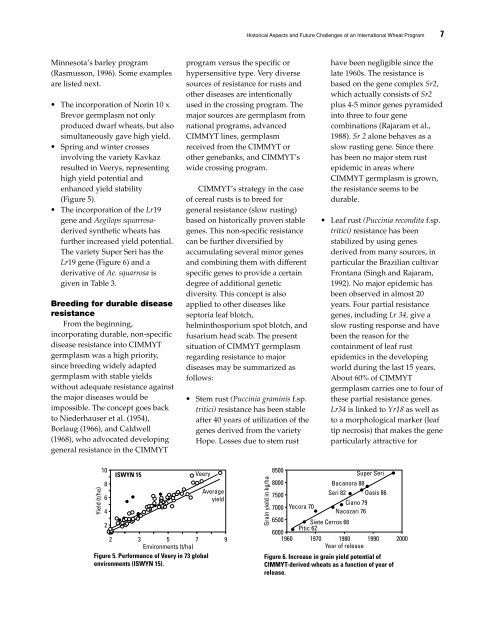Septoria and Stagonospora Diseases of Cereals - CIMMYT ...
Septoria and Stagonospora Diseases of Cereals - CIMMYT ...
Septoria and Stagonospora Diseases of Cereals - CIMMYT ...
Create successful ePaper yourself
Turn your PDF publications into a flip-book with our unique Google optimized e-Paper software.
Minnesota’s barley program<br />
(Rasmusson, 1996). Some examples<br />
are listed next.<br />
• The incorporation <strong>of</strong> Norin 10 x<br />
Brevor germplasm not only<br />
produced dwarf wheats, but also<br />
simultaneously gave high yield.<br />
• Spring <strong>and</strong> winter crosses<br />
involving the variety Kavkaz<br />
resulted in Veerys, representing<br />
high yield potential <strong>and</strong><br />
enhanced yield stability<br />
(Figure 5).<br />
• The incorporation <strong>of</strong> the Lr19<br />
gene <strong>and</strong> Aegilops squarrosaderived<br />
synthetic wheats has<br />
further increased yield potential.<br />
The variety Super Seri has the<br />
Lr19 gene (Figure 6) <strong>and</strong> a<br />
derivative <strong>of</strong> Ae. squarrosa is<br />
given in Table 3.<br />
Breeding for durable disease<br />
resistance<br />
From the beginning,<br />
incorporating durable, non-specific<br />
disease resistance into <strong>CIMMYT</strong><br />
germplasm was a high priority,<br />
since breeding widely adapted<br />
germplasm with stable yields<br />
without adequate resistance against<br />
the major diseases would be<br />
impossible. The concept goes back<br />
to Niederhauser et al. (1954),<br />
Borlaug (1966), <strong>and</strong> Caldwell<br />
(1968), who advocated developing<br />
general resistance in the <strong>CIMMYT</strong><br />
Yield (t/ha)<br />
10<br />
8<br />
6<br />
4<br />
2<br />
ISWYN 15<br />
2 3 5<br />
Environments (t/ha)<br />
7 9<br />
Figure 5. Performance <strong>of</strong> Veery in 73 global<br />
environments (ISWYN 15).<br />
Historical Aspects <strong>and</strong> Future Challenges <strong>of</strong> an International Wheat Program 7<br />
program versus the specific or<br />
hypersensitive type. Very diverse<br />
sources <strong>of</strong> resistance for rusts <strong>and</strong><br />
other diseases are intentionally<br />
used in the crossing program. The<br />
major sources are germplasm from<br />
national programs, advanced<br />
<strong>CIMMYT</strong> lines, germplasm<br />
received from the <strong>CIMMYT</strong> or<br />
other genebanks, <strong>and</strong> <strong>CIMMYT</strong>’s<br />
wide crossing program.<br />
<strong>CIMMYT</strong>’s strategy in the case<br />
<strong>of</strong> cereal rusts is to breed for<br />
general resistance (slow rusting)<br />
based on historically proven stable<br />
genes. This non-specific resistance<br />
can be further diversified by<br />
accumulating several minor genes<br />
<strong>and</strong> combining them with different<br />
specific genes to provide a certain<br />
degree <strong>of</strong> additional genetic<br />
diversity. This concept is also<br />
applied to other diseases like<br />
septoria leaf blotch,<br />
helminthosporium spot blotch, <strong>and</strong><br />
fusarium head scab. The present<br />
situation <strong>of</strong> <strong>CIMMYT</strong> germplasm<br />
regarding resistance to major<br />
diseases may be summarized as<br />
follows:<br />
• Stem rust (Puccinia graminis f.sp.<br />
tritici) resistance has been stable<br />
after 40 years <strong>of</strong> utilization <strong>of</strong> the<br />
genes derived from the variety<br />
Hope. Losses due to stem rust<br />
Veery<br />
Average<br />
yield<br />
have been negligible since the<br />
late 1960s. The resistance is<br />
based on the gene complex Sr2,<br />
which actually consists <strong>of</strong> Sr2<br />
plus 4-5 minor genes pyramided<br />
into three to four gene<br />
combinations (Rajaram et al.,<br />
1988). Sr 2 alone behaves as a<br />
slow rusting gene. Since there<br />
has been no major stem rust<br />
epidemic in areas where<br />
<strong>CIMMYT</strong> germplasm is grown,<br />
the resistance seems to be<br />
durable.<br />
• Leaf rust (Puccinia recondita f.sp.<br />
tritici) resistance has been<br />
stabilized by using genes<br />
derived from many sources, in<br />
particular the Brazilian cultivar<br />
Frontana (Singh <strong>and</strong> Rajaram,<br />
1992). No major epidemic has<br />
been observed in almost 20<br />
years. Four partial resistance<br />
genes, including Lr 34, give a<br />
slow rusting response <strong>and</strong> have<br />
been the reason for the<br />
containment <strong>of</strong> leaf rust<br />
epidemics in the developing<br />
world during the last 15 years.<br />
About 60% <strong>of</strong> <strong>CIMMYT</strong><br />
germplasm carries one to four <strong>of</strong><br />
these partial resistance genes.<br />
Lr34 is linked to Yr18 as well as<br />
to a morphological marker (leaf<br />
tip necrosis) that makes the gene<br />
particularly attractive for<br />
8500<br />
Super Seri<br />
8000<br />
Bacanora 88<br />
7500<br />
Seri 82 Oasis 86<br />
7000 Yecora 70<br />
Ciano 79<br />
Nacozari 76<br />
6500<br />
6000<br />
1960<br />
Siete Cerros 66<br />
Pitic 62<br />
1970 1980<br />
Year <strong>of</strong> release<br />
1990 2000<br />
Figure 6. Increase in grain yield potential <strong>of</strong><br />
<strong>CIMMYT</strong>-derived wheats as a function <strong>of</strong> year <strong>of</strong><br />
release.<br />
Grain yield in kg/ha









